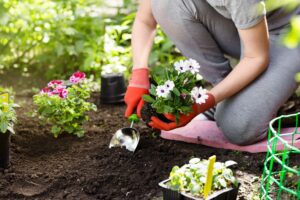As the season for outdoor activities and social gatherings approaches, many of us look forward to sprucing up our outdoor spaces. Whether you aim to craft the perfect outdoor entertainment area, or simply want to enhance the aesthetic appeal and value of your home with a stunning garden, there’s no time like the present to cultivate your gardening skills. Here are some insightful tips to help you create an enchanting garden that blooms with life and beauty this summer.
Understanding Your Garden
Before you start mapping out your garden, it’s crucial to understand its unique characteristics. Is your garden north or south-facing? The amount and direction of sunlight your garden receives can dictate what plants will thrive and where to place them. Carefully consider which plants and flowers complement each other and suit your garden’s conditions. With thoughtful planning, you can create a structured garden that maintains its charm throughout the year.

Working with Soil
Soil condition is fundamental to your garden’s success. Avoid digging or planting in wet soil, as it can harm the soil structure. Wait until the weather is favourable and the soil is dry and crumbly to start planting. You can determine the soil’s readiness by squeezing a handful of it; if it forms a ball, it’s too wet to work with.
Gradual Progress
While it can be tempting to overhaul your garden as soon as the weather permits, it’s more beneficial to work gradually. Start by addressing small but urgent tasks like pruning trees and cleaning patios. This approach allows you to progressively reveal your garden’s potential without becoming overwhelmed.
Zoning Your Garden
Maximise your garden space by assigning distinct zones for different functions such as lounging areas and flower beds. You can creatively define these zones using various elements like paths, walls, box hedges, or even swathes of wildflowers.
Container Gardening
If space is limited, containers can be a brilliant solution. You can grow a wide range of plants, including vegetables, herbs, flowers, fruit trees, berries, and shrubs in pots of various shapes, sizes, and colours. Just ensure the pots are large enough for their respective plants and positioned securely to prevent toppling over.
Welcoming Wildlife
Contrary to what some may think, welcoming wildlife into your garden can be beneficial. Birds can help control pests such as slugs, snails, caterpillars, and aphids, while bees are essential for pollination. Consider creating habitats in your garden to attract critters like frogs, hedgehogs, butterflies, and bees. Sharing your garden with wildlife can enhance your gardening experience and contribute to local biodiversity.

Conclusion
Gardening is a rewarding endeavour that can transform your outdoor space into a vibrant sanctuary and add value to your home. By understanding your garden’s unique characteristics, nurturing your soil, working gradually, thoughtfully zoning your garden, making use of containers, and welcoming wildlife, you can create a garden that is both functional and beautiful. Each step you take towards cultivating your garden brings you closer to the joy of outdoor living in a space that truly reflects your tastes and needs.
Frequently Asked Questions
Q1: How do I determine if my garden is north or south-facing?
A1: You can use a compass or a smartphone compass app to determine the direction your garden faces. The amount of sunlight your garden receives can also indicate its orientation. South-facing gardens typically get more sunlight throughout the day.
Q2: What should I do if my soil is too wet for planting?
A2: If your soil is too wet, wait# This search is to find a more detailed answer to the question “What should I do if my soil is too wet for planting?” search(“What to do if soil is too wet for planting”)
Wait until it dries out before you proceed with planting. Overly wet soil can lead to root rot because it limits the amount of oxygen available to the plant roots. Some ways to dry out wet soil include:
- Increasing the light exposure of your plant. More light can speed up the plant’s water usage. However, ensure that the light level is suitable for the specific plant you’re growing.
- Discarding any excess water that the plant may be sitting in.
- Removing the plant from its pot and placing the root ball on a layer of newspaper, which can absorb excess water. Replace the newspaper a few times until it has removed as much water as possible.
- Avoiding fertilization of a plant that’s been overwatered, as it can exacerbate the situation.
If the problem persists, consider repotting your plant. Remove as much waterlogged soil as possible from the roots, cut off any brown or mushy roots, and then repot the plant in a fresh soil mixture that contains additional coarse material like perlite to create air pockets in the soil. After repotting, let the surface of the soil dry before watering the plant again1.
Q3: How do I create zones in my garden?
A3: You can create zones in your garden by designating specific areas for different functions. For instance, you could have a zone for outdoor seating, another for growing flowers, and another for growing vegetables. You can define these zones using various elements such as paths, walls, box hedges, or swathes of wildflowers.
Q4: How can I attract wildlife to my garden?
A4: To attract wildlife to your garden, consider creating habitats that cater to different animals. For instance, bird feeders can attract birds, while a small pond can attract frogs. Planting a variety of flowers can help attract bees and butterflies, while leaving some areas of your garden a bit wilder can provide shelter for animals like hedgehogs. Remember to avoid using pesticides, as these can harm wildlife.








